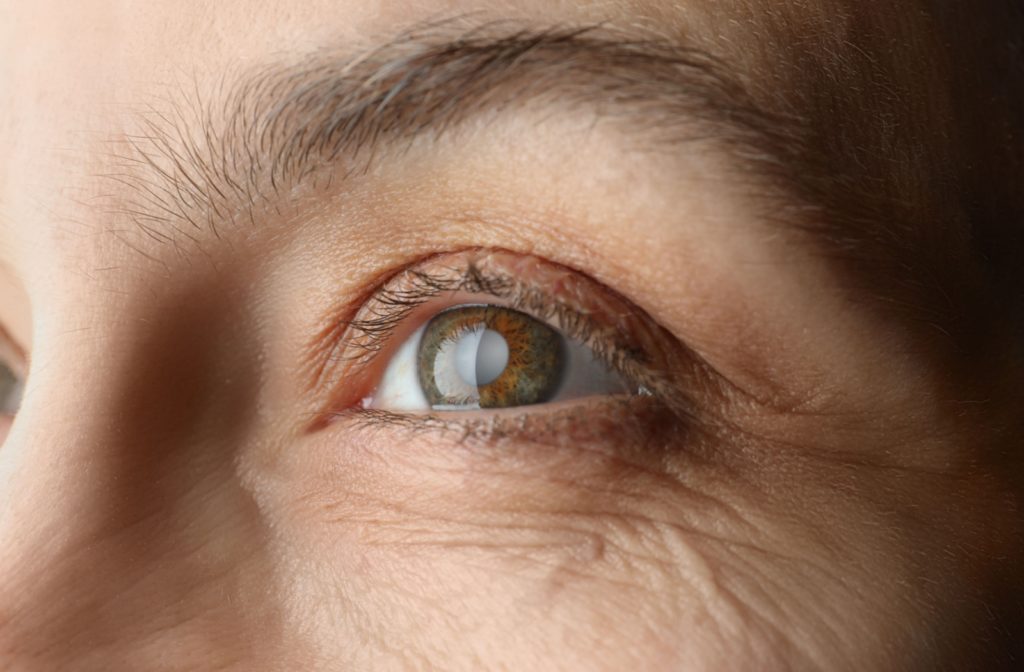Driving at night can be daunting for many, especially for seniors who face the challenge of cataracts. You’re not alone if you’re squinting more than usual or feeling uneasy behind the wheel after dusk.
Typically, driving with cataracts at night is unsafe because they make it harder for your eyes to judge distances and can give delayed reactions. Still, you can use some strategies–like anti-glare eyeglasses, increasing your following distance, or ensuring your car has proper lighting–to practice safer nighttime driving.
What Are Cataracts?
Cataracts occur when the eye’s lens becomes more rigid, appearing as a milky, opaque clouding on the ordinarily transparent lens. This cloudiness occurs because proteins in the lens break down and clump together, scattering light and making it difficult for the eye to focus correctly. This condition develops slowly and is often related to aging, but it can be exacerbated by diabetes, sun damage, smoking, and high blood pressure.
Cataracts are one of the leading causes of vision impairment globally, affecting millions of people each year. However, they are treatable, and understanding more about them is a crucial first step in managing the condition. Given their prevalence, it’s essential for anyone experiencing symptoms to seek professional advice. Early detection can significantly improve potential treatment outcomes, reducing cataracts’ impact on one’s life.
How Do Cataracts Affect Vision?
Cataracts, which range from mild to severe, primarily affect vision by causing cloudiness. This cloudiness can distort the light that enters the eye, making it difficult to see clearly. Vision with cataracts can become:
- Blurred or hazy, like looking through a fogged-up window.
- Sensitive to light and glare because the cloudy lens allows light to scatter more than usual
- Faded, particularly colors that appear duller or yellowish as the lens loses its clarity and ability to differentiate colors accurately.
These symptoms can significantly impact daily activities, especially those that require sharp vision, like driving.
Night vision, in particular, can deteriorate considerably. Low-light conditions are challenging for those with cataracts because the eye struggles to capture enough light for clear vision. This reduction in visual acuity at night can make tasks like driving more hazardous, especially when dealing with oncoming headlights or poorly lit roads.
How Cataracts Affect Driving at Night
Driving at night with cataracts presents unique challenges.
- Glare from streetlights, headlights, and reflective surfaces can scatter within the eye, causing halos or starbursts that obscure your view of the road.
- Reduction in contrast sensitivity makes it more challenging to distinguish between changes in the road environment, road signs, and signals.
- Reduced depth perception can lead to difficulties gauging the speed of oncoming vehicles or the proximity of traffic signals.
These factors can create a stressful and potentially dangerous driving experience after dark.

How to Increase Safety on the Road With Cataracts
Several strategies can help individuals with cataracts improve their night vision and nighttime driving safety.
- Ensure that your car is equipped with clean, high-quality headlights. Adjust them if necessary to optimize visibility without creating glare for other drivers.
- Purchase anti-reflective lenses for your eyeglasses to help reduce glare from headlights and streetlights, allowing for clearer vision.
- Wear sunglasses daily to help your eyes adjust better to nighttime lighting conditions.
- Plan your routes carefully. Opt for well-lit roads and avoid unfamiliar routes at night. If possible, schedule longer drives during daylight hours to minimize the potential risks of nighttime driving.
Alternative Nighttime Transportation Methods
When nighttime driving becomes too challenging, exploring alternative transportation options can provide peace of mind.
- Carpooling with friends or family who are more comfortable driving at night allows you to share the responsibility and enjoy the company of others.
- Public transportation can offer safe and reliable travel without the stress of navigating the roads yourself. Many cities also provide ride-sharing services, which can be convenient and flexible.
- Service-based transportation apps that allow you to hire a driver can be a convenient travel method when you don’t feel comfortable driving yourself.
Remember, your safety is paramount, and plenty of options are available to ensure you reach your destination safely.
Cataracts Treatment
If you find workarounds for cataracts start to be too much for you to handle, it’s worth considering surgical intervention, which is one of the most typical treatment routes for cataracts. Cataract surgery is one of the most common and successful surgical procedures worldwide. During the surgery, the cloudy lens is removed and replaced with a synthetic lens, restoring clear vision.
While surgery is practical, not all cataracts require immediate removal. In the early stages, improving lighting conditions in your home, using magnifying lenses, and managing glare with appropriate eyewear can help maintain your quality of life.
Your eye specialist should monitor you regularly. They can help determine the right time for surgery by assessing how cataracts affect your daily activities and overall vision.
The Importance of Regular Eye Exams for Detecting Cataracts
Regular eye exams are vital for early detection and management of cataracts. During these exams, your eye doctor can identify the early signs of cataracts before you notice any symptoms. Early detection allows for timely intervention and treatment planning.
A comprehensive eye exam every one to two years is recommended for adults over sixty. Maintaining a routine check-up schedule ensures you stay ahead of any vision changes and receive the necessary care to preserve your sight. Regular eye exams are crucial to maintaining optimal eye health, allowing for early detection and timely intervention. Safety on the road is paramount; taking proactive steps can make a difference.
Total Vision knows that having cataracts can bring many challenges, including worrying about nighttime driving. Contact us today to see how we can help you correct refractive errors or consult you on surgical options to manage your cataract condition.



